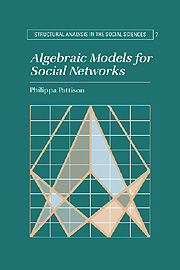Book contents
- Frontmatter
- Contents
- List of figures and tables
- Preface
- 1 Algebraic representations for complete social networks
- 2 Algebraic representations for local social networks
- 3 Comparing algebraic representations
- 4 Decompositions of network algebras
- 5 An analysis for complete and local networks
- 6 Time-dependent social networks
- 7 Algebras for valued networks
- 8 Issues in network analysis
- References
- Appendix A Some basic mathematical terms
- Appendix B Proofs of theorems
- Author index
- Subject index
7 - Algebras for valued networks
Published online by Cambridge University Press: 21 October 2009
- Frontmatter
- Contents
- List of figures and tables
- Preface
- 1 Algebraic representations for complete social networks
- 2 Algebraic representations for local social networks
- 3 Comparing algebraic representations
- 4 Decompositions of network algebras
- 5 An analysis for complete and local networks
- 6 Time-dependent social networks
- 7 Algebras for valued networks
- 8 Issues in network analysis
- References
- Appendix A Some basic mathematical terms
- Appendix B Proofs of theorems
- Author index
- Subject index
Summary
The partially ordered semigroups and local role algebras analysed in earlier chapters were constructed for complete and local networks of binary relations. In chapters 1 and 2, though, we also described complete and local networks that have valued links. In valued networks, a link from node i to node j on relation R has a value vR (i, j) indicating the value, or strength, of the relation of type R from i to j. For many date collection procedures, the values vR (i, j) may take only a finite set of possible values (and, of course, if the number of distinct possible values is just 2, the relations are binary). Both partially ordered semigroups and local role algebras may be defined for network data arising in this form, and in this chapter, we describe how to construct them. We also discuss the relationship between the algebraic structures derived from valued network data and the algebraic structures introduced in chapters 1 and 2 for binary data.
The semigroup of a valued network
For complete networks, valued relational information may be generated directly as a result of the methodology used in the network study, or it may arise as a result of some preliminary processing of the network data. The first type of data is generated when network ties are measured using a procedure that allows for ordinally scaled responses, with more than two possible response values.
- Type
- Chapter
- Information
- Algebraic Models for Social Networks , pp. 238 - 250Publisher: Cambridge University PressPrint publication year: 1993



